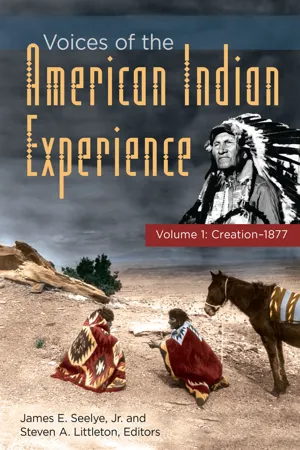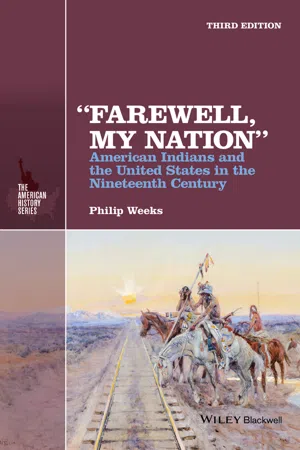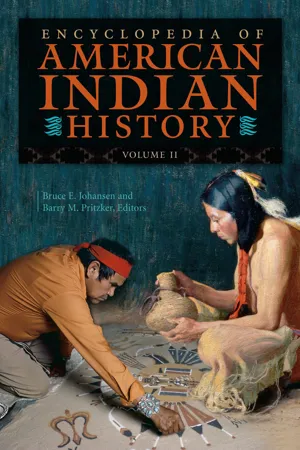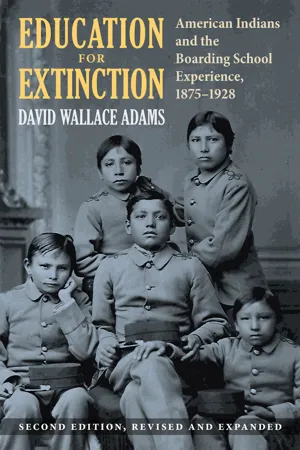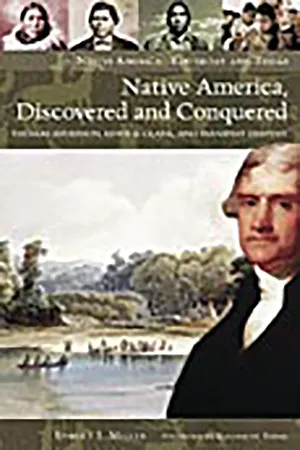History
Dawes Act
The Dawes Act, passed in 1887, aimed to assimilate Native Americans into mainstream American society by breaking up their communal land ownership and distributing individual plots of land to tribal members. This policy was intended to encourage farming and private land ownership among Native Americans, but it ultimately led to the loss of millions of acres of indigenous land and the erosion of tribal cultures and autonomy.
Written by Perlego with AI-assistance
Related key terms
1 of 5
10 Key excerpts on "Dawes Act"
- eBook - ePub
Voices of the American Indian Experience
[2 volumes]
- James E. Seelye Jr., Steven Alden Littleton, James E. Seelye Jr., Steven Alden Littleton(Authors)
- 2012(Publication Date)
- Greenwood(Publisher)
Among the parts of the reservation to be so assigned to Indians in severalty retain alternate races or townships for white settlers. Let only men of such character as a suitable commission would approve be allowed to file on these lands. Let especial advantages in price of land, and in some cases let a small salary be offered, to induce worth farmers thus to settle among the Indians as object-teachers of civilization. Let the parts of the reservations not needed be sold by the Government for the benefit of the Indians, and the money thus realized be used to secure this wide intermingling of the right kind of civilized men with the Indians. Over all, extend the law of the States and Territories, and let Indian and white man stand alike before the law.Source: Seventeenth Annual Report of the Board of Indian Commissioners (1885) , 17–19, 26–35; reprinted in Francis Paul Prucha, ed. Americanizing the American Indians: Writings by the “Friends of the Indian,” 1880–1900 , 45–54. Lincoln, NE: University of Nebraska Press, 1978.Passage contains an image
101
The Dawes Act (1887): An Act to Provide for the Allotment of Lands in Severalty to Indians on the Various Reservations (General Allotment Act or Dawes Act)
This act, passed by Congress in 1887 and amended several times, provided for the division of tribally held lands into individually owned parcels. Additionally, the act opened the surplus lands of each tribe to purchase and settlement by non-Indians. It is estimated that over the life of the act, from 1887 to its repeal in 1934, Native Americans lost two-thirds of their 1887 land holdings (mostly to non-Indian settlers and railroad companies). Additionally, the act negatively affected unity, tribal self-government, and Native American cultures. In many cases, allotments were not sufficient for economic activities and land holdings became fractionalized as allotments were passed down to future generations. The effects of the Dawes Act have been both significant and long lasting. - eBook - PDF
Disciplinary Spaces
Spatial Control, Forced Assimilation and Narratives of Progress since the 19th Century
- Andrea Fischer-Tahir, Sophie Wagenhofer, Andrea Fischer-Tahir, Sophie Wagenhofer(Authors)
- 2017(Publication Date)
- transcript Verlag(Publisher)
16 Unallotted lands would be purchased by the government and opened to settlement. 11 ARCIA 1881: xxii. 12 Although Richard Coke introduced bills at each session of Congress until 1884, his later co-sponsor Dawes soon assumed control over the legislation and Coke’s role was largely forgotten (see Hoxie 1989: 72; Prucha 1986: 666-667). 13 United States Statutes at Large, 24 (1887): 389. 14 Leonard Carlson (1981) argues that the government implemented the Dawes Act where and when Western settlers and developers demanded it. 15 This change helped protect married women, who would become landless under the original legislation if their marriages dissolved (Prucha 1976: 257-258). 16 Prior to this time, individual Indians could only become citizens by specific act of Congress (Prucha 1986: 231). T HE 1887 D AWES A CT 100 | E MILY G REENWALD In order to protect allotments from being sold, the Dawes Act included a 25-year trust period. Only after the trust period expired would allottees receive fee patents (outright titles) to their lands, allowing them to sell. Soon, however, Congress began making inroads on the trust period, passing amendments that permitted Indians to lease or sell their allotments, thereby continuing the process of transforming Indian space into Euroamerican space. 17 The Dawes Act’s unstated spatial control agenda was not necessarily an unintended one. The Politicians’ and reformers’ rhetoric about allotment clearly indicates the hope to reorder the spatial dimensions of Indians’ lives. They wanted to assert Euroamerican territorial authority, and they wanted to replace Indians’ systems of land division and patterns of movement with Euroamerican ones. But late 19th century politicians and reformers lacked the vocabulary for articulating their intentions in spatial terms. Instead, they used a language of cultural and economic Americanization to justify the Dawes Act. - eBook - PDF
How the Indians Lost Their Land
Law and Power on the Frontier
- Stuart Banner, Stuart BANNER(Authors)
- 2009(Publication Date)
- Belknap Press(Publisher)
Y 8 Allotment Each of the major programs that characterized nineteenth-century In-dian land policy was supported by a coalition of the Indians’ friends and foes, and each proved disastrous for the Indians. Removal, in the early part of the century, and reservations, in the middle, each had the sup-port of two kinds of people—whites trying to protect the Indians by placing them apart, and whites trying to obtain their land. In each case, it was clear within a decade or two that only the latter group achieved its goal. This process took place yet again at the end of the century, when white humanitarians turned to what they hoped would be a different method of helping the Indians. In a variety of areas, from education to political participation, Indian policy turned from segregation to assimila-tion. 1 As applied to land, the ideal of assimilation took the form of the General Allotment Act, or Dawes Act, of 1887, which envisioned carving up the Indian reservations into fee simple plots owned by individuals and families, in the same way whites owned their land. The Dawes Act, as amended every few years, remained in effect until 1934. From the Indians’ perspective the result was, once again, disaster. Many supporters of allotment were trying to protect the Indians from losing more of their land, but allotment also had the support of many who wanted to accelerate land loss, and once again it was the latter goal that was achieved. Between 1887 and 1934 the Indians lost most of their remaining land—86 million acres out of the 138 million in their posses-sion in 1887. One of the goals of allotment was to encourage Indian farming, but during the period of allotment the extent of Indian farming declined, both absolutely and relative to whites. 2 Making matters worse, by 1934 much of the Indians’ remaining land was owned in patterns so complex as to impose debilitating consequences on the nominal owners, consequences that have persisted up through today. - eBook - PDF
"Farewell, My Nation"
American Indians and the United States in the Nineteenth Century
- Philip Weeks(Author)
- 2015(Publication Date)
- Wiley-Blackwell(Publisher)
The communal tribal The Search for a New Order 304 lands that the federal government designated as surplus—that is, those lands not allocated—were thrown open to Americans for settlement, delighting potential land‐grabbers among others. Senator Henry Teller of Colorado predicted, with tragic accu- racy, that forty years after the passage of allotment legislation, when the Indians had lost most of their private plots of land to white people, they would “curse the hand that was raised pro- fessedly in their defense.” Teller’s prediction became the sad experience of Indians throughout the West. The Dawes Act proved to be disastrous for tribes by taking away from them nearly 108 million acres of reservation land deemed surplus, or 70 percent of the total that was left them in the 1870s at the conclusion of the Indian wars. One notable illustration of the senator’s dire forecast coming true was the fate of the Indian Territory, an enormous slice of the aggregate lands reserved for tribes and safeguarded for them, supposedly forever, by the United States. The Indian Territory had played a central role in United States–American Indian rela- tions throughout the nineteenth century. Its complex story began when the Indian Territory was established in the 1830s under the policy of Separation, the national government’s initial solution to solve the Indian Question. Congress reserved it for the exclusive use of the members of the Five Civilized Tribes following their various Trail of Tears experiences as they were removed from the American South. Thirty years later, the United States government imposed the Reconstruction Treaties of 1866 as penalty for these five tribes’ involvement with the Southern Confederacy during the Civil War. A large share of their land was taken from them and used to facilitate the new policy of Concentration, the government’s sec- ond solution for solving the Indian Question. - eBook - PDF
Encyclopedia of American Indian History
[4 volumes]
- Bruce E. Johansen, Barry M. Pritzker, Bruce E. Johansen, Barry M. Pritzker(Authors)
- 2007(Publication Date)
- ABC-CLIO(Publisher)
Although American Indian people of the lower forty-eight have endured numerous federal Indian policies, it would be unthinkable today not to ask their opinion on a policy that would have such a devastating impact on their livelihood. Let that be a lesson of history. Fed- eral Indian policies change every twenty years. Some of them are pro-Indian and some of them are anti- Indian. The policy of allotment need not be repeated. Jeanne Eder See also Assimilation; Bureau of Indian Affairs: Establishing the Existence of an Indian Tribe; Ceremonies, Criminalization of; Citizenship; Domestic Dependent Nation; Economic Development; Genocide; Land, Identity and Ownership of, Land Rights; Plenary Power; Reservation Economic and Social Conditions; Tribal Sovereignty; Trust, Doctrine of; Wardship Doctrine. References and Further Reading Billington, Ray Allen. 1982. Westward Expansion. Englewood Cliffs, N.J., Prentice Hall. “Dawes Act (1887).” Available at: http://www .ourdocuments.gov. Accessed June 23, 2006. Getches, David H., Daniel M. Rosenfelt, and Charles F. Wilkinson. 1979. Federal Indian Law: Cases and Materials. St. Paul, MN: West. Jackson, Helen 1994. A Century of Dishonor. New York: Barnes & Noble. Oklahoma State University Library. “Indian Affairs: Laws and Treaties.” Available at: http://digital .library.okstate.edu/kappler/. Accessed June 23, 2006. Otis, Delos Sacket. 1973. The Dawes Act and the Allotment of Indian Land. Norman: University of Oklahoma Press. Powell, Father Peter. 1977. “The Sacred Treaty.” In The Great Sioux Nation: Sitting in Judgment on America. Roxanne Dunbar. Ed. Ortiz. Berkeley, CA: Moon Books. Prucha, Francis Paul 1975. Documents of United States Indian Policy. Lincoln: University of Nebraska Press. Prucha, Francis Paul. 1984. The Great Father: The United States Government and the American Indians. Lincoln: University of Nebraska Press. Pyne, John, and Gloria Sesso. - eBook - ePub
Education for Extinction
American Indians and the Boarding School Experience, 1875–1928
- David Wallace Adams(Author)
- 2024(Publication Date)
- University Press of Kansas(Publisher)
Rather than relying on their own manhood for survival, Indians now saw the “Great Father” as the source of all their earthly needs. Finally, under the reservation system, Indians had little motivation to invest their labor in a farm that might be swept away in a new Indian removal program. As Welsh explained: “An Indian labors with no assurance whatsoever that he shall enjoy the scanty fruits of his toil, for no sooner has he abandoned the tent of roving day, and built himself a rude cabin of logs, and begun to gladden the ground about his dwelling with a little crop of corn, and wheat, and potatoes, than the greedy eye of some white neighbor spies his success, and Congress knows no peace until he is driven westward.” For these reasons, Lyman Abbott pronounced, the reservation had to be “uprooted root, trunk, branch, and leaf, and a new system put in its place.” 31 The solution, reformers argued, lay in the allotment of Indian land in severalty. Allotment would smash the tribal connection, force Indians to work the land, and eventually bring an end to the rationing system. In 1887, Congress passed the General Allotment Act, more commonly referred to as the Dawes Act, named after its sponsor Henry Dawes, the venerable senator from Massachusetts. Under the new legislation the president was authorized to identify selected reservations suitable for allotment, after which the following provisions were initiated. First, the reservation was surveyed and divided up among the Indians: 160 acres to each family head, 80 acres to single persons and orphans over eighteen years, and 40 acres to single persons under eighteen. Second, to protect allottees from avaricious whites, the actual deed to the allotment remained in the hands of the government for twenty-five years, during which time the land could not be sold or encumbered - eBook - ePub
- Robert Warrior(Author)
- 2014(Publication Date)
- Routledge(Publisher)
6). Allotment policies were directed at dissolving the tribes and the extinguishment of tribal land. After the U.S. Civil War, it was evident that the national government was not accomplishing its goal of cultural transformation. Critics claimed that the Indian reservation system was cursed (Gibson, 1984, p. 29). 15 Advocates of the allotment policies argued that individual property ownership was a necessity if Indians were to be converted from a savage and primitive way of life toward a settled, agrarian, and civilized one (Royster, 1995, p. 9). By the time the General Allotment Act (Dawes Act) was passed in 1887, most of the tribes in the US had been relocated to Indian reservations, warfare victims of ill-begotten Indian treaties. Federal officials clamored that the failure of the detribalization process was on account of the Indian reservation system that allowed Indian governments to hold their reservation lands in common. This nourished a belief that a tribal government’s resolve could not be broken until the reservation system was abolished. They advocated that it would be the private ownership of land, allotment in severalty that would accomplish what two decades of reservation oversight could not. When Congress authorized the Dawes Act, “Indians were to receive allotments of land in severalty, and the remaining surplus lands were to be opened to settlement” (Royster, 1995, p. 9). Moreover, advocates of assimilation believed that “non-Indian settlement interspersed with Indian allotments, would promote interaction between citizens and Indians and thus encourage the allottees to adopt White ways” (Gibson, 1984, pp. 29–30). It was believed that allotment would do away with tribal communal lands that prevented Indians from participating in fully American citizenship. Charles C - eBook - PDF
Domestic Contradictions
Race and Gendered Citizenship from Reconstruction to Welfare Reform
- Priya Kandaswamy(Author)
- 2021(Publication Date)
- Duke University Press Books(Publisher)
By linking the heteropatriarchal family and pri-vate property, the Dawes Act sought to eliminate collective land claims by dividing Native lands into individual allotments granted to male heads of households. This practice simultaneously restructured kinship and land re-lations, transforming diverse understandings of kin into legally recognized heteropatriarchal family units headed by men and transforming collective claims to land into private property. Not only did allotment “free up” for non-Native settlement any lands that remained in excess of individual allot-ments, but it also established private property, a legal construct of the settler colonial state, as the universal framework through which relationships to land would be negotiated. By privatizing kinship, the Dawes Act sought to remake Native peoples in the image of the heteropatriarchal nuclear family, transforming diverse structures of belonging into governable male- headed households that were easily recognized and controlled by the set-tler colonial state. 37 A vivid example of the reciprocal relationship between making state, making family | 43 the making of national and familial domestic spaces that I highlight in this book, the Dawes Act demonstrates how state efforts to organize Native peoples into heteropatriarchal family units enabled the expansion of the settler colonial state and vice versa. Boarding schools also functioned as primary institutions through which colonists sought to eliminate queer indigeneity. Perhaps most succinctly expressed in Richard Pratt’s philosophy of “kill the Indian, save the man,” the objective of boarding schools was to eradicate Native cultures and civi-lize Native children by inculcating them with settler colonial norms. 38 In doing so, they devalued Native reproductive labor, working to curtail the reproduction of Native communities by disrupting both those commu-nities’ claims to their children and Native children’s sense of belonging within their communities. - eBook - ePub
American Indian Policy and American Reform
Case Studies of the Campaign to Assimilate the American Indians
- Christine Bolt(Author)
- 2023(Publication Date)
- Routledge(Publisher)
After 1887, additional legislation applied allotment to the Sioux, the Chippewas of Minnesota, tribes in Montana, Idaho and Washington, and the Five Civilized Tribes. The Dawes Act was also altered several times. In 1891, primarily in order to protect divorced wives, it was ruled that each individual should receive 80 acres, rather than 160 acres going to the head of a household; and the Secretary of the Interior was empowered to authorize the leasing of allotments made to children, old people and others thought to be incapable of farming. The grounds on which leasing might be permitted were later enlarged. From 1901, the Secretary was authorized to sell heirship allotments; that is, holdings which were held in trust but where the original allottee had died. In 1906, the Burke Act provided that allottees were not to become citizens until they were deemed legally competent to take care of their own affairs; the trust period could be extended beyond twenty-five years, yet an individual might be declared competent before the twenty-five years were over. A person who was deemed competent could sell his land, which became liable for local and state property taxes. And in 1907, the Commissioner of Indian Affairs was granted the power to sell the allotment of a trust status Indian. This amending legislation perpetuated the basic paradox of the Dawes Act by simultaneously attempting to 'emancipate' the Indians and to provide special protection for them.The severalty law operated as most whites had hoped and most Indians had feared. An estimated 9,894 fee patents were issued between 1906 and 1916, another 10,956 between 1917 and 1920, and from 1887 to the 1930s, when allotment was halted, the Indians lost 91 million acres, so that their land base dwindled from 139 to 48 million acres. Indians without experience of commercial transactions were persuaded to part with their territory by waiting buyers and often wasted their suddenly acquired assets. Those who retained their land tended to be left in possession of the most arid and undesirable stretches of terrain, entirely unsuitable for homesteading. Much of the alienated land was in the 'surplus' category, but allotments, too, were disposed of with disturbing speed. It has been calculated that between 1900 and 1934 almost a half of Indian allotments had been released on fee patents, the majority of which had been sold or forfeit for non-payment of taxes, while by 1916 over a third of allotted agricultural lands was leased, thus defeating the legislators' ostensible intention of encouraging Indian agriculture.82 Harassed BIA officials, lacking adequate instruction about how to judge competence, frequently approved the applications of individuals who turned out to be the very opposite. Leasing arrangements proved hard to monitor and illegal contracts soon flourished. The determining of heirs to allotments and the settlement of debates between them over petty amounts of land and money were nightmarish tasks which distracted bureau employees from 'instructing Indians in the methods of land use'.83 - eBook - PDF
Native America, Discovered and Conquered
Thomas Jefferson, Lewis & Clark, and Manifest Destiny
- Robert J. Miller(Author)
- 2006(Publication Date)
- Praeger(Publisher)
In addition, the United States continued to exercise its preemption 170 Native America, Discovered and Conquered power to buy land from tribes with their putative consent through the treaty process. The very powerful United States treated the Indian Nations like the limited sovereigns Discovery defined them as being. The increasing domination of the United States over Indian Nations became evident in what is called the Allotment and Assimilation era, which is considered to have run from 1887 to 1934. The United States now more strongly than ever exercised its authority over Indians with very little, and then later no, tribal input or consent. Moreover, Congress radically altered the policies of the treaties and the Reservation era and breached the limits of its alleged Discovery power over Indian property by unilaterally altering the nature of tribal real-property rights under the General Allotment Act of 1887. The goal of this legislation was to break up tribal ownership of land, open the reservations for non-Indian settlement, and end tribal existence, all without tribal consent. Congress accomplished this task by dividing or allotting many tribally owned reservations into 160- and 80-acre plots that were then granted in individual ownership to family heads and indi- vidual adult tribal members. Any reservation land in excess of what was needed to allot a share to each tribal citizen was called “surplus” and was sold to non-Indian settlers who then moved onto the reservations. In addition, a significant amount of the land allotted to tribal citizens was ultimately lost from Indian ownership by voluntary sales and state tax foreclosures. The Allotment era resulted in a loss of about two-thirds of all tribally owned lands from 138 million acres in 1887 to 48 million acres by 1934. In addition, nearly 20 million acres of the remaining 48 million acres of tribally owned lands in 1934 were arid or semi-arid.
Index pages curate the most relevant extracts from our library of academic textbooks. They’ve been created using an in-house natural language model (NLM), each adding context and meaning to key research topics.
